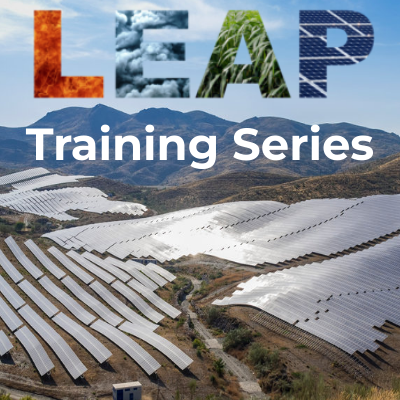Introductory LEAP training course: Undertaking cost-benefit analysis and optimization modelling with LEAP and NEMO

This training course is an output of the SEI Initiative on Integrated Climate and Development Planning, which leverages technological and methodological advances and strategic approaches to reach both climate and development aims. The initiative builds and reinforces capacity of in-country planners to achieve their goals, and to enhance their ambitions.
Overview
This page shares resources for lectures #5 and #6 of an eight-part introductory training course on the Low Emissions Analysis Platform (LEAP) modelling tool for energy, environmental, and economic analysis.
Video recordings, presentation slides and an exercise for these two lectures are provided below.
Click here to go to the course homepage
LEAP Training Lecture #5: Cost-benefit analysis with LEAP
This fifth lecture introduces how to undertake cost-benefit analysis with LEAP. Costs can be included in energy and non-energy modelling in LEAP. Real social costs are typically used and both undiscounted and discounted costs can be reported. LEAP avoids double counting energy costs by drawing a consistent boundary around costing analysis
This lecture covers the key definitions, concepts, and methods that you need to know to perform cost-benefit analysis using LEAP.
A video recording of the lecture is provided below.
LEAP Training Lecture #6: Optimization modelling with LEAP and NEMO
This sixth lecture introduces optimisation modelling with LEAP and NEMO, the Next Energy Modelling system for Optimization– a high-performance, open-source energy system optimization tool. This optimization modelling incorporates and considers financial investment, operations, impacts, limits, and vulnerabilities.
This lecture covers optimization modelling concepts and implementation in LEAP and NEMO.
A video recording of the lecture is provided below.
Presentation slides for Lectures #5 and #6
The presentation slides for these first two lectures are provided below. You can alsodownload the slides here.
Sida LEAP Training Lectures #5 and #6: Cost-benefit analysis and optimization modeling with LEAP and NEMOTraining Exercises 3 and 4: Cost-benefit analysis and optimization modelling
There are numerous training exercises available in LEAP’s Training Area (login required – open access). These are available in multiple languages including English, Spanish, Chinese, French, Italian, Indonesian, Vietnamese, Croatian, and Farsi.
These training exercises introduce you to LEAP, the Low Emissions Analysis Platform, and how it can be applied to energy and environmental analysis. The exercises are normally used as part of LEAP training courses (as in this course). They assume that you have some background in energy issues and familiarity with Windows-based software, including spreadsheets (such as Microsoft Excel).
Exercises for lectures 5 & 6
Exercise 3: Cost-benefit analysis
This exercise will show you how to enter data to describe the costs of various demand and supply- side technologies, and then to do an integrated cost-benefit analysis of various policy scenarios.
- This exercise is described in detail in chapter 4 of the “Main Training Exercises” document available in LEAP’s Training Area.
- Follow a video walk-through of exercise 3 below or on YouTube.
Exercise 4: Optimization modeling
This simple exercise will show you how to use LEAP’s optimization features with NEMO to investigate a range of different technologies for generating electricity. You will compare the costs of generating electricity including the capital, operating and maintenance and fuel costs of those technologies, and you will perform sensitivity analyses to examine which options are the cheapest when the externality costs of local air pollution are either included or excluded. You will then go on to explore the implications of a cap on CO2 emissions – how it alters the set of technologies chosen and how it affects the overall cost of the scenario.
- This exercise is described in detail in Training Exercise: Optimization with LEAP and NEMO.
- This exercise uses a supporting Excel file –Yearly Shape Data.xlsx (please download).
Continue the course
-
Go to lectures 7 & 8: Linking LEAP and WEAP and other advanced topics
-
Revisit lectures 3 & 4: Modelling energy supply and emissions with LEAP
-
Go to the course homepage
Citation Guidelines
Proper citation is important to the visibility and impact of the LEAP software system. We thank you for your commitment to cite LEAP correctly. Please include the following citation when publishing any results, analyses, tables or images generated by LEAP in any form (e.g. print, electronic, etc.):
Heaps, C.G., 2022. LEAP: The Low Emissions Analysis Platform. [Software version: 2020.1.64] Stockholm Environment Institute. Somerville, MA, USA. https://leap.sei.org
(0) Comments
There is no content